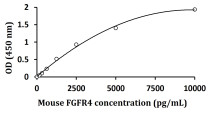Mouse FGFR4 ELISA Kit
CAT.NO. : ARG82563
US$ Please choose
US$ Please choose
Size:
Trail, Bulk size or Custom requests Please contact us
内含物
| 货号 | 内含物名称 | 包装 | 温度 |
|---|---|---|---|
| ARG82563-001 | Antibody-coated microplate | 8 X 12 strips | 4°C. Unused strips should be sealed tightly in the air-tight pouch. |
| ARG82563-002 | Standard | 2 X 10 ng/vial | 4°C |
| ARG82563-003 | Standard/Sample diluent | 30 ml (Ready to use) | 4°C |
| ARG82563-004 | Antibody conjugate concentrate (100X) | 1 vial (100 µl) | 4°C |
| ARG82563-005 | Antibody diluent buffer | 12 ml (Ready to use) | 4°C |
| ARG82563-006 | HRP-Streptavidin concentrate (100X) | 1 vial (100 µl) | 4°C |
| ARG82563-007 | HRP-Streptavidin diluent buffer | 12 ml (Ready to use) | 4°C |
| ARG82563-008 | 25X Wash buffer | 20 ml | 4°C |
| ARG82563-009 | TMB substrate | 10 ml (Ready to use) | 4°C (Protect from light) |
| ARG82563-010 | STOP solution | 10 ml (Ready to use) | 4°C |
| ARG82563-011 | Plate sealer | 4 strips | Room temperature |
概述
| 产品描述 | ARG82563 Mouse FGFR4 ELISA Kit is an Enzyme Immunoassay kit for the quantification of Mouse FGFR4 in serum, plasma (EDTA, heparin, citrate) and cell culture supernatants. |
|---|---|
| 反应物种 | Ms |
| 应用 | ELISA |
| 靶点名称 | FGFR4 |
| 偶联标记 | HRP |
| 偶联标记说明 | Substrate: TMB and read at 450 nm. |
| 灵敏度 | 62.3 pg/ml |
| 样品类型 | Serum, plasma (EDTA, heparin, citrate) and cell culture supernatants. |
| 标准范围 | 156 - 10000 pg/ml |
| 样本量 | 100 µl |
| 精确 | Intra-Assay CV: 4.9% Inter-Assay CV: 5.9% |
| 別名 | TKF; FGFR-4; CD antigen CD334; JTK2; CD334; EC 2.7.10.1; Fibroblast growth factor receptor 4 |
应用说明
| 检测时间 | ~ 5 hours |
|---|
属性
| 形式 | 96 well |
|---|---|
| 存放说明 | Store the kit at 2-8°C. Keep microplate wells sealed in a dry bag with desiccants. Do not expose test reagents to heat, sun or strong light during storage and usage. Please refer to the product user manual for detail temperatures of the components. |
| 注意事项 | For laboratory research only, not for drug, diagnostic or other use. |
生物信息
| 数据库连接 | Swiss-port # Q03142 Mouse Fibroblast growth factor receptor 4 |
|---|---|
| 基因名称 | FGFR4 |
| 全名 | fibroblast growth factor receptor 4 |
| 背景介绍 | The protein encoded by this gene is a member of the fibroblast growth factor receptor family, where amino acid sequence is highly conserved between members and throughout evolution. FGFR family members differ from one another in their ligand affinities and tissue distribution. A full-length representative protein would consist of an extracellular region, composed of three immunoglobulin-like domains, a single hydrophobic membrane-spanning segment and a cytoplasmic tyrosine kinase domain. The extracellular portion of the protein interacts with fibroblast growth factors, setting in motion a cascade of downstream signals, ultimately influencing mitogenesis and differentiation. The genomic organization of this gene, compared to members 1-3, encompasses 18 exons rather than 19 or 20. Although alternative splicing has been observed, there is no evidence that the C-terminal half of the IgIII domain of this protein varies between three alternate forms, as indicated for members 1-3. This particular family member preferentially binds acidic fibroblast growth factor and, although its specific function is unknown, it is overexpressed in gynecological tumor samples, suggesting a role in breast and ovarian tumorigenesis. [provided by RefSeq, Jul 2008] |
| 生物功能 | Tyrosine-protein kinase that acts as cell-surface receptor for fibroblast growth factors and plays a role in the regulation of cell proliferation, differentiation and migration, and in regulation of lipid metabolism, bile acid biosynthesis, glucose uptake, vitamin D metabolism and phosphate homeostasis. Required for normal down-regulation of the expression of CYP7A1, the rate-limiting enzyme in bile acid synthesis, in response to FGF19. Phosphorylates PLCG1 and FRS2. Ligand binding leads to the activation of several signaling cascades. Activation of PLCG1 leads to the production of the cellular signaling molecules diacylglycerol and inositol 1,4,5-trisphosphate. Phosphorylation of FRS2 triggers recruitment of GRB2, GAB1, PIK3R1 and SOS1, and mediates activation of RAS, MAPK1/ERK2, MAPK3/ERK1 and the MAP kinase signaling pathway, as well as of the AKT1 signaling pathway. Promotes SRC-dependent phosphorylation of the matrix protease MMP14 and its lysosomal degradation. FGFR4 signaling is down-regulated by receptor internalization and degradation; MMP14 promotes internalization and degradation of FGFR4. Mutations that lead to constitutive kinase activation or impair normal FGFR4 inactivation lead to aberrant signaling. [UniProt] |
| 细胞定位 | Cell membrane; Single-pass type I membrane protein. Endosome. Endoplasmic reticulum. Note=Internalized from the cell membrane to recycling endosomes, and from there back to the cell membrane. Isoform 2: Secreted. Isoform 3: Cytoplasm. [UniProt] |
| 产品亮点 | Related products: FGFR4 antibodies; FGFR4 ELISA Kits; New ELISA data calculation tool: Simplify the ELISA analysis by GainData |
| 翻译后修饰 | N-glycosylated. Full maturation of the glycan chains in the Golgi is essential for high affinity interaction with FGF19. Ubiquitinated. Subject to proteasomal degradation when not fully glycosylated. Autophosphorylated. Binding of FGF family members together with heparan sulfate proteoglycan or heparin promotes receptor dimerization and autophosphorylation on tyrosine residues. Autophosphorylation occurs in trans between the two FGFR molecules present in the dimer. [UniProt] |
 New Products
New Products





















